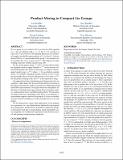| dc.contributor.author | Ellis, David | |
| dc.contributor.author | Kindler, Guy | |
| dc.contributor.author | Lifshitz, Noam | |
| dc.contributor.author | Minzer, Dor | |
| dc.date.accessioned | 2025-06-12T17:59:19Z | |
| dc.date.available | 2025-06-12T17:59:19Z | |
| dc.date.issued | 2024-06-10 | |
| dc.identifier.isbn | 979-8-4007-0383-6 | |
| dc.identifier.uri | https://hdl.handle.net/1721.1/159398 | |
| dc.description.abstract | If G is a group, we say a subset S of G is product-free if the equation xy=z has no solutions with x,y,z ∈ S.In 1985, Babai and Sós [] asked, for a finite group G, how large a subset S⊆ G can be if it is product-free. The main tool (hitherto) for studying this problem has been the notion of a quasirandom group. For D ∈ ℕ, a group G is said to be D-quasirandom if the minimal dimension of a nontrivial complex irreducible representation of G is at least D. Gowers showed that in a D-quasirandom finite group G, the maximal size of a product-free set is at most |G|/D1/3. This disproved a longstanding conjecture of Babai and Sós from 1985. For the special unitary group, G=(n), Gowers observed that his argument yields an upper bound of n−1/3 on the measure of a measurable product-free subset. In this paper, we improve Gowers’ upper bound to exp(−cn1/3), where c>0 is an absolute constant. In fact, we establish something stronger, namely, product-mixing for measurable subsets of (n) with measure at least exp(−cn1/3); for this product-mixing result, the n1/3 in the exponent is sharp. Our approach involves introducing novel hypercontractive inequalities, which imply that the non-Abelian Fourier spectrum of the indicator function of a small set concentrates on high-dimensional irreducible representations. Our hypercontractive inequalities are obtained via methods from representation theory, harmonic analysis, random matrix theory and differential geometry. We generalize our hypercontractive inequalities from (n) to an arbitrary D-quasirandom compact connected Lie group for D at least an absolute constant, thereby extending our results on product-free sets to such groups. We also demonstrate various other applications of our inequalities to geometry (viz., non-Abelian Brunn-Minkowski type inequalities), mixing times, and the theory of growth in compact Lie groups. A subsequent work due to Arunachalam, Girish and Lifshitz uses our inequalities to establish new separation results between classical and quantum communication complexity. | en_US |
| dc.publisher | ACM|Proceedings of the 56th Annual ACM Symposium on Theory of Computing | en_US |
| dc.relation.isversionof | https://doi.org/10.1145/3618260.3649626 | en_US |
| dc.rights | Article is made available in accordance with the publisher's policy and may be subject to US copyright law. Please refer to the publisher's site for terms of use. | en_US |
| dc.source | Association for Computing Machinery | en_US |
| dc.title | Product Mixing in Compact Lie Groups | en_US |
| dc.type | Article | en_US |
| dc.identifier.citation | Ellis, David, Kindler, Guy, Lifshitz, Noam and Minzer, Dor. 2024. "Product Mixing in Compact Lie Groups." | |
| dc.contributor.department | Massachusetts Institute of Technology. Department of Mathematics | en_US |
| dc.identifier.mitlicense | PUBLISHER_POLICY | |
| dc.eprint.version | Final published version | en_US |
| dc.type.uri | http://purl.org/eprint/type/ConferencePaper | en_US |
| eprint.status | http://purl.org/eprint/status/NonPeerReviewed | en_US |
| dc.date.updated | 2025-06-01T07:46:57Z | |
| dc.language.rfc3066 | en | |
| dc.rights.holder | The author(s) | |
| dspace.date.submission | 2025-06-01T07:46:57Z | |
| mit.license | PUBLISHER_POLICY | |
| mit.metadata.status | Authority Work and Publication Information Needed | en_US |
